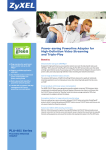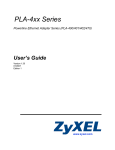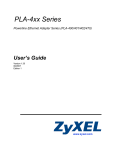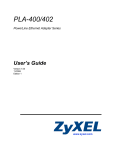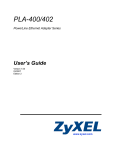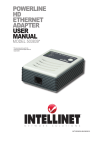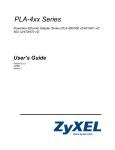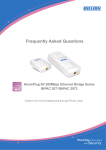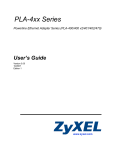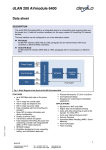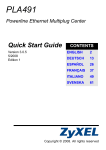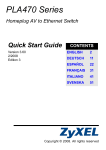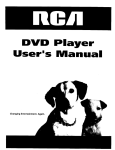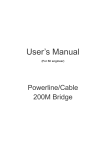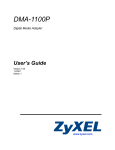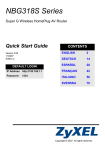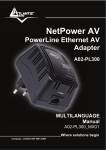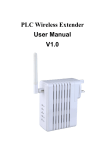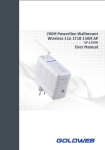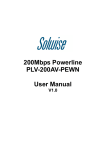Download ZyXEL PLA-407 User's Manual
Transcript
PLA-407 Powerline Pass-Thru Ethernet Adapter Firmware Version 4.0.1 Edition 1, 8/2009 www.zyxel.com www.zyxel.com Copyright © 2009 ZyXEL Communications Corporation About This User's Guide About This User's Guide Intended Audience This manual is intended for people who want to configure the PLA-407 using the web configurator. Tips for Reading User’s Guides On-Screen When reading a ZyXEL User’s Guide On-Screen, keep the following in mind: • If you don’t already have the latest version of Adobe Reader, you can download it from http://www.adobe.com. • Use the PDF’s bookmarks to quickly navigate to the areas that interest you. Adobe Reader’s bookmarks pane opens by default in all ZyXEL User’s Guide PDFs. • If you know the page number or know vaguely which page-range you want to view, you can enter a number in the toolbar in Reader, then press [ENTER] to jump directly to that page. • Type [CTRL]+[F] to open the Adobe Reader search utility and enter a word or phrase. This can help you quickly pinpoint the information you require. You can also enter text directly into the toolbar in Reader. • To quickly move around within a page, press the [SPACE] bar. This turns your cursor into a “hand” with which you can grab the page and move it around freely on your screen. • Embedded hyperlinks are actually cross-references to related text. Click them to jump to the corresponding section of the User’s Guide PDF. Related Documentation • Quick Start Guide The Quick Start Guide is designed to help you get your PLA-407 up and running right away. It contains information on setting up your network and configuring for Internet access. • Support Disc Refer to the included CD for support documents. PLA-407 User’s Guide 3 About This User's Guide Documentation Feedback Send your comments, questions or suggestions to: [email protected] Thank you! The Technical Writing Team, ZyXEL Communications Corp., 6 Innovation Road II, Science-Based Industrial Park, Hsinchu, 30099, Taiwan. Need More Help? More help is available at www.zyxel.com. • Download Library Search for the latest product updates and documentation from this link. Read the Tech Doc Overview to find out how to efficiently use the User Guide, Quick Start Guide and Command Line Interface Reference Guide in order to better understand how to use your product. • Knowledge Base If you have a specific question about your product, the answer may be here. This is a collection of answers to previously asked questions about ZyXEL products. • Forum This contains discussions on ZyXEL products. Learn from others who use ZyXEL products and share your experiences as well. 4 PLA-407 User’s Guide About This User's Guide Customer Support Should problems arise that cannot be solved by the methods listed above, you should contact your vendor. If you cannot contact your vendor, then contact a ZyXEL office for the region in which you bought the device. See http://www.zyxel.com/web/contact_us.php for contact information. Please have the following information ready when you contact an office. • Product model and serial number. • Warranty Information. • Date that you received your device. Brief description of the problem and the steps you took to solve it. PLA-407 User’s Guide 5 Document Conventions Document Conventions Warnings and Notes These are how warnings and notes are shown in this User’s Guide. Warnings tell you about things that could harm you or your device. Note: Notes tell you other important information (for example, other things you may need to configure or helpful tips) or recommendations. Syntax Conventions • The PLA-407 may be referred to as the “PLA-407”, the “ZyXEL device”, the “device” or the “Powerline adapter” in this User’s Guide. • The PLA-4xx Series Configuration Utility version 3.3.4(AG) may be referred to as the “configuration utility” or the “utility” in this User’s Guide. • Product labels, screen names, field labels and field choices are all in bold font. • A key stroke is denoted by square brackets and uppercase text, for example, [ENTER] means the “enter” or “return” key on your keyboard. • “Enter” means for you to type one or more characters and then press the [ENTER] key. “Select” or “choose” means for you to use one of the predefined choices. • A right angle bracket ( > ) within a screen name denotes a mouse click. For example, Maintenance > Log > Log Setting means you first click Maintenance in the navigation panel, then the Log sub menu and finally the Log Setting tab to get to that screen. • Units of measurement may denote the “metric” value or the “scientific” value. For example, “k” for kilo may denote “1000” or “1024”, “M” for mega may denote “1000000” or “1048576” and so on. • “e.g.,” is a shorthand for “for instance”, and “i.e.,” means “that is” or “in other words”. 6 PLA-407 User’s Guide Document Conventions Icons Used in Figures Figures in this User’s Guide may use the following generic icons. The PLA-407 icons used may not be an exact representation of your device. PLA-407 Computer Internet Modem / Router Printer Notebook TV PLA-407 User’s Guide 7 Safety Warnings Safety Warnings • Do NOT use this product near water, for example, in a wet basement or near a swimming pool. • Do NOT expose your device to dampness, dust or corrosive liquids. • Do NOT store things on the device. • Do NOT install, use, or service this device during a thunderstorm. There is a remote risk of electric shock from lightning. • Connect ONLY suitable accessories to the device. • Do NOT open the device or unit. Opening or removing covers can expose you to dangerous high voltage points or other risks. ONLY qualified service personnel should service or disassemble this device. Please contact your vendor for further information.Make sure to connect the cables to the correct ports. • Place connecting cables carefully so that no one will step on them or stumble over them. • Always disconnect all cables from this device before servicing or disassembling. • Use ONLY an appropriate power adapter or cord for your device. • Connect the power adapter or cord to the right supply voltage (for example, 110V AC in North America or 230V AC in Europe). • Do NOT allow anything to rest on the power adapter or cord and do NOT place the product where anyone can walk on the power adapter or cord. • Do NOT use the device if the power adapter or cord is damaged as it might cause electrocution. • If the power adapter or cord is damaged, remove it from the power outlet. • Do NOT attempt to repair the power adapter or cord. Contact your local vendor to order a new one. • Do not use the device outside, and make sure all the connections are indoors. There is a remote risk of electric shock from lightning. • Do NOT obstruct the device ventilation slots, as insufficient airflow may harm your device. • This power unit is intended to be correctly orientated in a vertical or floor mount position. • CAUTION: Use only in dry locations • To reduce the risk of show-use only indoors. • For Household Use Only. Your product is marked with this symbol, which is known as the WEEE mark. WEEE stands for Waste Electronics and Electrical Equipment. It means that used electrical and electronic products should not be mixed with general waste. Used electrical and electronic equipment should be treated separately. 8 PLA-407 User’s Guide Table of Contents Table of Contents About This User's Guide .......................................................................................................... 3 Document Conventions............................................................................................................ 6 Safety Warnings........................................................................................................................ 8 Table of Contents...................................................................................................................... 9 Part I: Introduction................................................................................. 13 Chapter 1 Introducing the PLA-407 ........................................................................................................15 1.1 Overview .............................................................................................................................. 15 1.1.1 Data Transfer ............................................................................................................. 16 1.1.2 Pass-Through Design ................................................................................................ 16 1.1.3 Noise Filter ................................................................................................................. 16 1.1.4 Quality of Service ....................................................................................................... 17 1.1.5 Low Power Mode ....................................................................................................... 18 1.2 Expand Your Network with the PLA-407 ............................................................................. 18 1.3 Ways to Manage the PLA-407 ............................................................................................. 19 1.4 Security ................................................................................................................................ 19 1.4.1 Passwords .................................................................................................................. 20 1.4.2 Setting Up Security .................................................................................................... 20 1.5 Multiple Networks ................................................................................................................ 21 Chapter 2 Installing the Utility................................................................................................................. 23 2.1 Overview .............................................................................................................................. 23 2.2 Installing the Utility ............................................................................................................... 23 Part II: Managing the PLA-407 .............................................................. 27 Chapter 3 Firmware Tool ......................................................................................................................... 29 3.1 Overview .............................................................................................................................. 29 3.2 Firmware Upgrade Tool ....................................................................................................... 29 PLA-402 v3 User’s Guide 9 Table of Contents Chapter 4 The ENCRYPT Button.............................................................................................................31 4.1 ENCRYPT Button Overview ................................................................................................ 31 4.2 Set Up a HomePlug AV Network with ENCRYPT ............................................................... 31 4.2.1 Expanding the Network with ENCRYPT .................................................................... 33 4.3 Setting Up Multiple Networks .............................................................................................. 33 4.4 ENCRYPT Button Behavior ................................................................................................. 36 Chapter 5 The Configuration Utility ........................................................................................................ 37 5.1 Overview .............................................................................................................................. 37 5.1.1 Powerline Network Security ....................................................................................... 37 5.1.2 Device Access Key (DAK) .......................................................................................... 38 5.2 Starting the Configuration Utility .......................................................................................... 38 5.3 Configuration Screen .......................................................................................................... 39 5.4 Firmware Screen ................................................................................................................ 41 5.5 Network Info Screen ........................................................................................................... 41 5.6 Advanced Screen ............................................................................................................. 43 5.7 About Screen ....................................................................................................................... 46 Chapter 6 The OS X Configuration Utility .............................................................................................. 47 6.1 Overview .............................................................................................................................. 47 6.1.1 System Requirements ................................................................................................ 47 6.1.2 Start the Configuration Utility ..................................................................................... 48 6.1.3 Add a Device .............................................................................................................. 48 6.1.4 Change Network Name .............................................................................................. 48 6.1.5 Change Nickname ...................................................................................................... 49 6.1.6 QoS Settings .............................................................................................................. 49 6.1.7 Set HomePlug Light Color .......................................................................................... 51 6.1.8 Link Information .......................................................................................................... 52 6.1.9 Download Firmware ................................................................................................... 54 6.2 Firmware Detection Tool ..................................................................................................... 54 6.3 Firmware Upgrade Tool ....................................................................................................... 56 6.3.1 Notes on Upgrading Firmware ................................................................................... 56 6.3.2 Procedure to Upgrade Firmware ................................................................................ 56 Chapter 7 Powerline Network Setup Tutorial......................................................................................... 61 7.0.1 Overview .................................................................................................................... 61 7.0.2 Important Terms ......................................................................................................... 62 7.0.3 Accessing Your Powerline Adapter ............................................................................ 62 7.0.4 Adding a Powerline Adapter ....................................................................................... 63 10 PLA-402 v3 User’s Guide Table of Contents 7.0.5 Setting Up a New Network with a New Adapter ......................................................... 65 7.0.6 Splitting a Network into Two Networks ....................................................................... 67 7.1 Troubleshooting ................................................................................................................... 70 Chapter 8 PLA Compatibility ................................................................................................................... 71 8.1 Overview .............................................................................................................................. 71 8.2 Firmware and Utility Compatibility ....................................................................................... 71 8.3 Compatibility Diagrams ........................................................................................................ 72 8.4 Chipset Compatibility ........................................................................................................... 73 Part III: Appendices and Index.............................................................. 75 Chapter 9 LEDs and Troubleshooting .................................................................................................... 77 9.1 LEDs .................................................................................................................................... 77 9.2 Power and Light Problems .................................................................................................. 79 9.3 Configuration Utility Problems ............................................................................................. 81 9.4 Powerline Problems ............................................................................................................. 81 9.5 ENCRYPT Button Problems ................................................................................................ 82 Chapter 10 Product Specifications ........................................................................................................... 85 Appendix A Legal Information ................................................................................................ 89 Index......................................................................................................................................... 93 PLA-402 v3 User’s Guide 11 Table of Contents 12 PLA-402 v3 User’s Guide P ART I Introduction Introducing the PLA-407 (15) Installing the Utility (23) 13 14 CHAPTER 1 Introducing the PLA-407 1.1 Overview This chapter introduces the main applications and features of the PLA-407 HomePlug AV compliant Powerline adapter. In this User’s Guide the electrical wiring network is referred to as the “Powerline network”. The HomePlug AV standard specifies how network devices communicate using standard electrical wiring. The PLA-407 plugs into an ordinary electrical outlet to easily extend a DSL broadband connection or existing Ethernet (LAN) network to any other electrical outlet in any room of a house, all without the need for any new cabling as shown in the following figure. Figure 1 PLA-407 Home Setup LEGEND Powerline Ethernet Gaming NSA Network Extension Video Streaming PLA-407 User’s Guide 15 Chapter 1 Introducing the PLA-407 1.1.1 Data Transfer The PLA-407 securely communicates with each other at high data transfer rates of up to 200 Mbps. The theoretical maximum channel data rate is 200 Mbps on the physical layer. The actual channel data rate will vary depending on noise on the electrical wires and the quality of your electrical installation. It uses 128-bit Advanced Encryption Standard (AES) to ensure safe transfer of information. 1.1.2 Pass-Through Design The PLA-407 has a power socket into which you can plug another electrical appliance, network device or power strip. It can support up to 16A current rating making it compatible with other electronic equipment used at home. Specifically, the PLA-407 supports the following current rating: • EU Type: AC socket, 100 - 240V ~ 16A (maximum), 50 - 60 Hz • US Type: AC socket, 100 - 240V ~ 15A (maximum), 50 - 60 Hz • UK Type: AC socket, 100 - 240V ~ 13A (maximum), 50 - 60 Hz This extra socket frees up an outlet for another device at the same time that your PLA-407 is plugged in. It is recommended that you plug in only network devices, such as your personal computer, computer monitor, router, Device Media Adapter (DMA) to name a few. Plugging in high current electrical devices (microwave, refrigerator and so on) can reduce the performance of the device. 1.1.3 Noise Filter When you plug in a power strip to the PLA-407’s power socket and use this power strip for other electrical devices in your home, the PLA-407 can filter out 16 PLA-407 User’s Guide Chapter 1 Introducing the PLA-407 interference from the electrical devices so that it does not affect the Powerline network. This is shown in the following figure. Figure 2 Noise Filter on PLA-407 Noise Filter Home Appliances Powerline Network This setup maximizes the PLA-407’s performance and ensures that the Powerline network is stable. This benefits users who are into gaming or those watching streaming media from the Internet. The internal noise filter is enabled by default. 1.1.4 Quality of Service Additionally, the Quality of Service (QoS) feature of the PLA-407 (refer to Section 5.6 on page 43) prioritizes voice, video and data traffic (such as web browsing, file transfer and e-mail). The figure below illustrates the advantage of implementing QoS. Figure 3 QoS on PLA-407 Without QoS All sorts of traffic With QoS Voice Equal Priority High Priority Video Data PLA-407 User’s Guide Low Priority 17 Chapter 1 Introducing the PLA-407 1.1.5 Low Power Mode Your PLA-407 is a certified green product. It goes into Low Power mode when there is no Ethernet connection. When you plug the PLA-407 into an electric socket, it waits for an Ethernet connection. When no connection is detected after sixty (60) seconds, the Power LED ( ) blinks indicating that it is going into Low Power mode. The same process occurs when you disconnect the PLA-407 from a previously working Ethernet connection. Sixty (60) seconds after disconnecting the Ethernet cable, the PLA-407’s Power LED blinks signalling that it is going into Low Power mode. The Ethernet and HomePlug LEDs are turned off in Low Power mode. While in Low Power mode, you cannot use the ENCRYPT button. To enable the ENCRYPT button again, you have to connect the PLA-407’s Ethernet cable to a computer/notebook or modem/router first. The PLA-407 wakes up from Low Power mode and you can start using the ENCRYPT button. Low Power mode is enabled by default. See Chapter 10 on page 85 for detailed product specifications. 1.2 Expand Your Network with the PLA-407 Connect your PLA-407 to an Internet gateway such as a modem and plug it into a power outlet in your home (1). Plug a second PLA-407 into another power outlet (2) and connect a computer to the PLA-407 for Internet access (3). Figure 4 Expand Your Network with the PLA-407 3 1 2 18 PLA-407 User’s Guide Chapter 1 Introducing the PLA-407 Your network can be further expanded by plugging additional PLA-407s into other power outlets in your home and connecting other computers or network devices (for example, a printer) to them. Refer to your Quick Start Guide for hardware connection information. 1.3 Ways to Manage the PLA-407 Use the ENCRYPT button to add Powerline devices to your Powerline network if they have this button. See Chapter 4 on page 31 for instructions on using the ENCRYPT feature. Use the PLA-4xx Series Configuration Utility (or utility, for short) to manage the PLA-407. See Section 2.2 on page 23 for instructions on installing the utility. Use the firmware upgrade tool to upgrade to the latest firmware. Because the latest PLA-407s are only compatible with other Powerline devices with the latest HomePlug AV firmware as well as the latest version Utility, this tool is available to help you upgrade. You can download this tool from the ZyXEL website (www.zyxel.com). See Chapter 3 on page 29 for information in using these tools. This User’s Guide describes the latest version utility. This utility is only compatible with a PLA-407 which has the latest firmware installed. If you don’t already have them, download the latest firmware and utility from the ZyXEL website. 1.4 Security Since your Powerline network may extend outside your premises, it is important to set up security on your PLA-407. PLA-407 User’s Guide 19 Chapter 1 Introducing the PLA-407 1.4.1 Passwords You use two types of passwords in the HomePlug AV Powerline network. The following table describes the differences between the passwords. Table 1 Password Summary PASSWORD DESCRIPTION Network Name All Powerline adapters that follow the HomePlug AV standard are shipped with the same Powerline network name “HomePlugAV”. Change the network name via the PLA-4xx Series Configuration Utility to create a private network. See Section 5.3 on page 39. DAK (Data Access Key) Password In order to manage the Powerline adapters on your Powerline network you must enter the adapters’ DAK password in the PLA-4xx Series Configuration Utility. This password is printed on the Powerline adapter itself. You don’t need to add the password for the Powerline adapter directly connected to the computer running the configuration utility (local Powerline adapter), you only have to add the remote Powerline adapters’ passwords (those on your circuit, but not directly connected to your computer). 1.4.2 Setting Up Security The ENCRYPT feature automatically sets up security on your Powerline network. Use this feature if your Powerline devices have the ENCRYPT button. If your devices do not have the ENCRYPT button, use the PLA-4xx Series Configuration Utility to set up security on the PLA-407. Although the PLA-407 is a “plug-and-play” network expanding solution there are several reasons for enabling security on the Powerline network in your home. 1 It’s easy and only requires you to change a network name. 2 It’s a good idea to ensure privacy of your communication. When you use the PLA407 and other Powerline adapters, the Powerline wiring in your home becomes an extension of your Ethernet network. Your network traffic flows freely within the electrical outlets of your home and is bounded in most cases by a power meter. Without security (encryption) your information is accessible to anyone using a Powerline adapter on the same electrical circuit. In some cases, a circuit can be shared by more than one household. To prevent compromising your network security, you can create a private network. A private network uses a secret password (Network Name) to make sure that only permitted Powerline adapters can communicate in your network. See Section 5.3 on page 39 for information on setting up a private network. 20 PLA-407 User’s Guide Chapter 1 Introducing the PLA-407 3 You may need to change the Network Name to create multiple Powerline networks. See the next section for more information on how to set up a multiple network. 1.5 Multiple Networks Multiple powerline networks can coexist on a single powerline circuit. You might want to implement multiple powerline networks in a small office environment where you have two separate Ethernet networks. 1 Connect one powerline adapter to a router or switch on the first Ethernet network and assign a Network Name (for example “Password1”) to this powerline adapter. Add additional powerline adapters to your network by plugging them into your powerline outlets and assigning them “Password1”. This completes the configuration of your first powerline network. 2 Connect another powerline adapter to a router or switch on the second Ethernet network and assign a different Network Name (for example “Password2”) to this powerline adapter. Again, add additional powerline adapters and assign them “Password2”. You now have two private networks on your powerline circuit. Information is not shared between the two networks as only powerline adapters with the same Network Name can communicate with each other. PLA-407 User’s Guide 21 Chapter 1 Introducing the PLA-407 22 PLA-407 User’s Guide CHAPTER 2 Installing the Utility 2.1 Overview This chapter guides you through the installation of the configuration utility for your PLA-407. The installation of the configuration utility does the following: 1 Checks for and installs Microsoft’s .NET Framework version 2.0 software on your computer. This software is necessary for the installation of the PLA-4xx Series Configuration Utility. If you already have .NET Framework version 2.0 installed on your computer this step will be skipped. Note: At the time of writing the utility is only compatible with Microsoft Windows XP, Microsoft Windows Vista (32-bit version), MAC OS 10.4 and MAC OS 10.5 operating systems. Users with Windows XP (64-Bit version) operating systems can go to Microsoft’s website to upgrade their systems to .NET Framework version 2.0 so it can work with the utility. To check for your Windows operating system version, right-click on My Computer > Properties. You should see this information in the General tab. 2 Installs ZyXEL’s PLA-4xx Series Configuration Utility. This utility allows you to manage the network name (See Section 5.3 on page 39 for more information) or view the devices recognized on your Powerline network. Note: This User’s Guide describes the latest version utility. This utility is only compatible with a PLA-407 which has the latest firmware installed. If you don’t already have them, download the latest firmware and utility from the ZyXEL website. 2.2 Installing the Utility Follow the steps below to install .NET Framework version 2.0 and the PLA-4xx Series Configuration Utility on your computer. PLA-407 User’s Guide 23 Chapter 2 Installing the Utility 1 Insert the included CD-ROM into your computer’s CD-ROM drive. The Setup utility runs automatically. Alternatively this can also be done manually by double clicking the setup.exe file on the CD. A prompt appears asking you to install the .NET Framework version 2.0. Review Microsoft’s License Agreement, select Accept to proceed. Figure 5 .NET Framework Installation Prompt 2 The next screen allows you to see the progress of the installation. Figure 6 .NET Framework Installation Process 24 PLA-407 User’s Guide Chapter 2 Installing the Utility 3 The Setup utility runs automatically. Click Yes or Next to continue through the initial screen. Click Cancel only if you want to abort the installation. Figure 7 InstallShield Wizard Start Screen 4 If you want the utility to be only available to the currently logged in user, select Only for me(...). Otherwise, click Everyone to allow all users to use the configuration utility. Click Next to install the utility to the default folder, or click Browse to specify a different location on your computer. Figure 8 Install Destination Folder Note: You can also click Disk Cost to know how much available disk space you have in the hard drives found in your computer. PLA-407 User’s Guide 25 Chapter 2 Installing the Utility 5 When the installation is finished, a screen appears to confirm that the PLA-4xx Series Configuration Utility has been successfully installed on your computer. Click Close to exit the wizard. Figure 9 Installation Complete Note: You may be asked to restart your computer when the installation is complete. Click “Yes” to restart your computer. If you select “No, I will restart my computer later”, you will not be able to launch the utility until after a restart of your computer. 26 PLA-407 User’s Guide P ART II Managing the PLA407 Firmware Tool (29) The ENCRYPT Button (31) The Configuration Utility (37) Powerline Network Setup Tutorial (61) PLA Compatibility (71) 27 28 CHAPTER 3 Firmware Tool 3.1 Overview Use the Firmware Upgrade Tool to ensure you have the latest firmware (version 4.0.1 or later) on your PLA-407(s). You need to upgrade all your PLA-407s to the latest firmware to ensure they can connect with each other and they are compatible with the latest version Utility. If your firmware is an early version (earlier than 4.0.1), then upgrade your firmware using the Firmware Upgrade Tool. 3.2 Firmware Upgrade Tool Use the firmware upgrade tool to upgrade your PLA-407’s firmware to the latest version. You can use this tool to upgrade the firmware on the Powerline device directly connected to your computer. This is necessary as devices with ZyXEL’s early version firmware are not compatible with the latest Utility or with devices running ZyXEL’s latest version firmware. At the time of writing, firmware version 4.0.1 is only available to PLA-407. This firmware version is compatible with version 3.3.4. Firmware version 3.3.4 is available to PLA-401 v3, PLA-402 v3 and PLA-407. Note: The firmware is included in the Tool. You do not need to download the firmware separately. PLA-407 User’s Guide 29 Chapter 3 Firmware Tool 30 PLA-407 User’s Guide CHAPTER 4 The ENCRYPT Button 4.1 ENCRYPT Button Overview The ENCRYPT button allows you to set up a secure Powerline connection with other HomePlug AV compliant Powerline devices which also support the ENCRYPT feature. No other setting changes are required to connect. You can use the ENCRYPT button to: • set up a new Powerline network • separate an existing Powerline network into multiple networks 4.2 Set Up a HomePlug AV Network with ENCRYPT You can connect a number of devices on a Powerline network, but you can use the ENCRYPT button on only two devices at a time. 1 Place a Powerline device close to another Powerline device so you have time to set up each one. After you set up the first Powerline device, you have 60 seconds to set up the second Powerline device. 2 You can disconnect them from your computer or modem (or other networking equipment) if you need to move them close to each other, but the Powerline devices need to be plugged into power outlets. Note: Because your PLA-407 goes into Low Power mode, it must be connected to a networking equipment for the ENCRYPT button to work. Refer to Section 1.1.5 on page 18 for more details. 3 Press the ENCRYPT button on your first Powerline device for more than 10 seconds until the power ( ) light flashes. This resets the network name to a random value and removes your device from any network it may belong to. PLA-407 User’s Guide 31 Chapter 4 The ENCRYPT Button 4 Press the ENCRYPT button on your second Powerline device for 1~2 seconds. The power ( ) light will blink as the PLA-407 tries to set up a connection. Figure 10 ENCRYPT Connection Procedure press for 2 seconds press for 2 seconds within 2 minutes Note: The ENCRYPT button’s location varies for each Powerline device. 5 Repeat step 4 in this section for any other Powerline device you wish to connect. This must be done within 60 seconds of pressing the ENCRYPT button on the PLA-407. 6 Check the lights on the Powerline devices. The power ( ) and HomePlug ( ) lights should be blinking while the devices are connecting. Several times all lights blink simultaneously and the HomePlug ( ) light also shows red. Wait for about one minute while your Powerline devices connect. If the power ( ) light does not blink when you press ENCRYPT, you have probably pressed the ENCRYPT button for too long. Try again, pressing the ENCRYPT button for 1~ 2 seconds. If the HomePlug ( ) lights on both Powerline devices do not light up, the Powerline devices are not connected. Repeat steps 4 and 5 in this section. If that doesn’t work, see the Troubleshooting in Section 9.5 on page 82 for suggestions. 32 PLA-407 User’s Guide Chapter 4 The ENCRYPT Button 4.2.1 Expanding the Network with ENCRYPT If you want to add more Powerline devices to your network after the initial setup (refer to Section 4.2 on page 31), do the following. 1 To add more Powerline devices to your network, press the ENCRYPT button on device C (shown below) for more than 10 seconds until the power ( ) light flashes. 2 Then repeat steps 4 and 5 in the previous section using any Powerline device (A or B) you have connected using ENCRYPT and the Powerline device you want to connect (C). You must use the ENCRYPT button on both devices. Figure 11 Adding More Powerline Adapters to Your Network B A A or B C 3 If you have previously disconnected your computer or modem (or any other networking product connected to your Powerline device), you can now reconnect them. This sets up your Powerline network between your Powerline devices. 4.3 Setting Up Multiple Networks You can use the ENCRYPT button to set up multiple Powerline networks using your existing Powerline network. PLA-407 User’s Guide 33 Chapter 4 The ENCRYPT Button For example, you have already set up a Powerline network in your home (A) which accesses a printer (B). Now you want a separate Powerline network connection from your laptop (C) to your printer. Figure 12 One Existing Powerline Network A B 34 C 1 Click the ENCRYPT button on (A) for more than 10 seconds until the power ( light flashes. This disconnects (A) from (B). 2 Click the ENCRYPT button on (A) and (C) for 1~2 seconds and within two minutes of each other. 3 Wait for about one minute while (A) and (C) connect. ) PLA-407 User’s Guide Chapter 4 The ENCRYPT Button 4 Check the LEDs on both (A) and (C). When the power ( ) and HomePlug ( lights stop blinking and the power ( ) light shines steadily, the devices are connected. ) Figure 13 Two Separate Powerline Networks B A C Congratulations. You now have two separate Powerline networks as shown above. If the HomePlug ( ) lights on both Powerline devices do not light up, the Powerline devices are not connected. Repeat the connection process, making certain you press the ENCRYPT buttons for the correct time and within two minutes of each other. If that does not work see Section 9.5 on page 82 for suggestions. PLA-407 User’s Guide 35 Chapter 4 The ENCRYPT Button 4.4 ENCRYPT Button Behavior The following table summarizes the actions that occur when the ENCRYPT button is pressed for specific lengths of time. Table 2 Time ENCRYPT Button is Pressed and Action HOMEPLUG LIGHT BEHAVIOR TIME ACTION POWER LIGHT BEHAVIOR less than 3 seconds The device joins a network. It shares the same network name as other devices on the network. The power ( ) light blinks until the device is connected. This may take a minute. The HomePlug ( ) light turns on if your device is connected to another Powerline device or a Powerline network. more than 10 seconds The device leaves any network it is associated with and its network name assumes a random value. The power ( ) light blinks several times and then shines steadily. The HomePlug ( ) light blinks red one time and then turns off when it disconnects from the Powerline network. See Troubleshooting in Chapter 9 on page 82 for suggestions on problems with the ENCRYPT button and the lights. 36 PLA-407 User’s Guide CHAPTER 5 The Configuration Utility 5.1 Overview This chapter shows you how to use the Configuration Utility (or Utility) to secure, manage and set up Quality of Service (QoS) on your Powerline network. The PLA-407 is designed as a plug-and-play network expanding solution. This means that once you complete your hardware connections, the PLA-407s in your network (without additional configuration) are able to communicate with each other by sending and receiving information over your home’s electrical wiring. Figure 14 Example Network Setup All HomePlug AV compliant Powerline adapters within range can join your network. The range varies depending on the quality of your home’s wiring. Note: See Section 5.1.1 on page 37 for more information on enhancing your Powerline network security. 5.1.1 Powerline Network Security When the PLA-407s communicate with each other, they use encryption to protect the information that is sent in the Powerline network. Encryption is like a secret code. If you do not know the secret code, you cannot understand the message. The HomePlug AV standard uses 128-bit AES (Advanced Encryption Standard) to safely transmit data between Powerline adapters. For the Powerline adapters to communicate with each other they all need to use the same network name. This network name allows the Powerline adapters to understand the encrypted information sent in the Powerline network. PLA-407 User’s Guide 37 Chapter 5 The Configuration Utility By default the PLA-407s are all configured with the network name HomePlugAV, this allows you to simply plug the devices in and not worry about setting up security. If you want to enhance the security on your Powerline network, you can change the network name on the Powerline adapters you want to allow to communicate in your Powerline network. 5.1.2 Device Access Key (DAK) In order to manage the Powerline adapters on your Powerline network you must enter the adapters’ password in the PLA-4xx Series Configuration Utility. This password is called the DAK (Device Access Key) password. This password is printed on the Powerline adapter itself. You don’t need to enter the DAK password for the Powerline adapter directly connected to the computer running the utility (local Powerline adapter), you only have to add the remote Powerline adapters’ passwords (those in your Powerline network, but not directly connected to your computer). 5.2 Starting the Configuration Utility To launch the PLA-4xx Series Configuration Utility simply double click on the configuration icon on your desktop. Figure 15 PLA-4xx Series Configuration Utility Icon Alternatively, start the utility by browsing to it from the start menu. Click Start > Programs > ZyXEL PLA-4xx Series Configuration > PLA-4xx Series Configuration Utility. Note: Close the Firmware Upgrade Tool and Firmware Detection Tool if either of them are open for the Utility to work properly. 38 PLA-407 User’s Guide Chapter 5 The Configuration Utility 5.3 Configuration Screen Use the Configuration screen to see which devices are recognized by your Powerline network, to configure your PLA-407 and to set up a secure Powerline network by changing the Powerline network name. This screen opens up when you launch the utility. Note: Use the Figure 16 icon to view online help information in each screen of the utility. Configuration Screen The following table describes the labels in this screen. Table 3 Configuration Screen LABEL DESCRIPTION Network Topology Use this to select which Powerline network information is displayed. Different Powerline networks are identified by the Ethernet interface (network card) connected directly to the PLA-407. Typically there is only one connection, however, if your computer has two network cards and both are connected to a Powerline device then you have two Powerline networks. The fields described below are used to identify the Powerline adapters recognized on the Powerline network. The configuration utility automatically updates this information every 10 seconds. Click Scan to refresh the information in these fields (immediately). Note: Only devices which share the same network name are displayed in this table. PLA-407 User’s Guide 39 Chapter 5 The Configuration Utility Table 3 Configuration Screen (continued) LABEL DESCRIPTION Site This field displays • • Local - This shows if PLA-407 is identifying the Powerline adapter directly connected to the computer running the configuration utility. Remote - This shows if PLA-407 is a Powerline adapter in your Powerline network but not directly connected to the computer running the configuration utility. MAC Address This is a read-only field which shows the MAC address of the Powerline adapter you are configuring. You can find the MAC address of your PLA407 displayed on a sticker on the bottom of your device. DAK Password This shows the DAK (Device Access Key), which is the password used to verify that you are authorized to perform changes on a remote device. You can find the DAK password printed on a sticker on the bottom of your PLA407. Status This shows Managed for ZyXEL Powerline devices that you can configure. Otherwise, this shows Unmanaged for non-ZyXEL devices detected in the Powerline network. DAK Password Select the remote Powerline adapter you want to manage by clicking the MAC address which corresponds to it in the MAC Address column. Enter the DAK Password value and click Save. Note: You must enter the DAK Password value exactly as it is printed on the label (all caps and with dashes “-”). Network Name (NMK) The default network name (sometimes called a network password or network membership key (NMK)) of the PLA-407 is “HomePlugAV”. HomePlug compatible devices use the same network name to recognize and communicate with each other over the Powerline network. If you change the network name of one device on the network, it will no longer be recognized as part of that network. If you change the network name, make sure you change the network name for all of the Powerline adapters that you want to be part of your Powerline network. The network name can be from 8 to 64 characters in length, using “A”~”Z”, “a”~”z”, “0”~”9”; spaces are not allowed. Set NMK to this device Select this to apply the NMK (entered in the field above) as the network name for the Powerline adapter directly connected to the computer running the configuration utility. Set NMK to all managed devices Select this to apply the NMK (entered in the field above) as the network name for all Powerline adapter detected by the utility. Write Click this to apply your changes. The new Network Name is applied to the selected Powerline adapter. Note: You must enter the correct DAK password for the selected Powerline adapter before you can make changes to it. 40 PLA-407 User’s Guide Chapter 5 The Configuration Utility 5.4 Firmware Screen Firmware is the software which is embedded in the PLA-407. This software contains processing instructions for how the PLA-407 sends and receives information in a secure way. You can check the ZyXEL website for firmware upgrades for your PLA-407. Note: To upgrade to the latest firmware, use the firmware upgrade tool available from the ZyXEL website (www.zyxel.com), or from the CD included with your PLA407. Make sure you also upgrade the PLA-4xx Series Configuration Utility if you do so, as older version utilities are not compatible with PLA-407s using the latest firmware. Click Firmware to open the screen as follows. Figure 17 Firmware Screen Be sure to upload the correct model firmware as uploading the wrong model firmware may damage your device. 5.5 Network Info Screen Use the Network Info screen to see the rates at which a specific PLA-407 is communicating with other Powerline adapters on your Powerline network. PLA-407 User’s Guide 41 Chapter 5 The Configuration Utility Click Network Info to display the following screen. Figure 18 Network Info Screen The following table describes the labels in this screen. Table 4 Network Info Screen LABEL DESCRIPTION Adapter This field identifies which Powerline network information is displayed. Different Powerline networks are identified by the Ethernet interface (network card) connected directly to the PLA-407. Typically there is only one connection, however, if your computer has two network cards and both are connected to a PLA-407, then you have two Powerline networks. Central Coordinator MAC The Central Coordinator of the Powerline network is the Powerline adapter which keeps track of which devices are part of the network as well as synchronizes communication within the Powerline network. If the Central Coordinator is removed from the Powerline network then another Powerline adapter takes its place. This field displays the MAC address of the PLA-407 which is the Central Coordinator of the Powerline network. The Powerline adapters in your Powerline network automatically select the Central Coordinator. The information provided in the following table reflects transmission rate information about the Powerline adapters which communicate in your Powerline network. Site This field displays: • • MAC Address 42 Local, if it is the PLA-407 directly connected to the computer running the configuration utility. Remote, if it is a PLA-407 in your Powerline network but not directly connected to the computer running the configuration utility. This field displays the MAC address of your Powerline adapter. The MAC address of your Powerline adapter can be found by looking at the label on your device. It consists of six pairs of hexadecimal characters (hexadecimal characters are “0-9” and “a-f”). In the case of the PLA-407, this label is on the bottom of the device. PLA-407 User’s Guide Chapter 5 The Configuration Utility Table 4 Network Info Screen (continued) LABEL DESCRIPTION Transmit Rate (Mbps) This field displays how fast information is sent from the Powerline adapter selected in the Configuration screen to this Powerline adapter. Receive Rate (Mbps) This field displays how fast information is received from the Powerline adapter selected in the Configuration screen to this Powerline adapter. 5.6 Advanced Screen Note: This feature is only available with the latest version utility. Go to the ZyXEL website to download the latest utility and firmware for your ZyXEL HomePlug AV adapter. You can configure the Powerline adapters on your network to give priority to network traffic depending on its importance. When you set the priority of a Powerline adapter, you set how quickly messages FROM your Powerline adapter are sent in your Powerline network. Transmissions TO your Powerline adapter do not receive any priority. For example, if you have a file server on your home network to deliver music and movie files to computers in your home, you should set the priority of the Powerline adapter connected to this server to Medium. If video traffic is delivered too slowly, quality problems may occur. On the other hand, a Powerline adapter attached to a printer should have a low priority setting since the slow delivery of messages will not affect the print job. Similarly, if you want to prioritize any downloads from the Internet, set the priority on the Powerline adapter attached to your Internet gateway to High. Allocate priority settings based on application type as follows. Table 5 Priority Settings PRIORITY LEVEL APPLICATION High Voice Application Medium Video and Audio Applications Normal Data Applications Low Data Applications PLA-407 User’s Guide 43 Chapter 5 The Configuration Utility The figure below shows an example Powerline home network connected to the Internet. Figure 19 Priority Settings C B D E A • Device A is a printer and does not handle traffic with high importance, so the Powerline adapter connected to it can be set to low priority. • Device B is a file server, delivering audio or movie files to other users on the network. The Powerline adapter attached to it should have a medium setting. • Device C, a home computer which connects to the Internet, can receive a normal priority setting as it usually sends simple requests for data. For example, when you surf the Internet, your computer sends requests to open web pages. • Device D is a modem attached to the Internet. It should receive a high priority setting if you want faster downloading through your network. • Although device E receives audio or movie files, it does not send a lot of traffic, so the Powerline adaptor attached to it can be set to a low priority. 44 PLA-407 User’s Guide Chapter 5 The Configuration Utility Use this screen to configure priority settings for traffic from the Powerline adapters on your network. Figure 20 Advanced Screen The following table describes the labels in this screen. Table 6 Advanced Screen LABEL DESCRIPTION Adapter This field identifies which Powerline network information is displayed. Different Powerline networks are identified by the Ethernet interface (network card) on your computer which is connected directly to a Powerline adapter. Typically there is only one connection. However, if your computer has two network cards and both are connected to a Powerline adapter, then you have two Powerline networks. Site This field displays: • • Local, if it is the PLA-407 directly connected to the computer running the configuration utility. Remote, if it is a Powerline adapter in your Powerline network but not directly connected to the computer running the configuration utility. MAC Address This is a read-only field which shows the MAC address of the Powerline adapter you are configuring. You can find the MAC address of your PLA407 displayed on a sticker on the bottom of your device. Priority Select a priority setting from the drop-down box for traffic FROM your selected device. The options, in order of importance, are High, Medium, Normal and Low. Save Click this to apply your changes. The new Priority setting is applied to the selected Powerline adapter. PLA-407 User’s Guide 45 Chapter 5 The Configuration Utility 5.7 About Screen Use the About screen to view information regarding the configuration utility and firmware version of the PLA-407 you are connected to. Click the icon in the top right corner of the utility to view the About screen. Figure 21 About Screen Upgrade to latest version utility and firmware. The following table describes the labels in this screen. Table 7 About Screen LABEL DESCRIPTION Utility version This field displays the software version of the configuration utility. Firmware version This field displays the firmware version of the device you selected in the Device Selection field of the Configuration screen. In the example firmware version given in the screen, 4-0-4011, the firmware version is shown by the numbers 40, meaning this is firmware version 4.0. Note: If your device’s firmware is earlier than 3.3.4, please use the Firmware Upgrade Tool to upgrade your firmware. 46 Released This field displays the date when the firmware was released. Close Click the button in upper right corner to close the About window. PLA-407 User’s Guide CHAPTER 6 The OS X Configuration Utility 6.1 Overview This chapter shows you how to use the configuration utility on a Mac computer with the Leopard operating system. See the User’s Guide Chapter 5 on page 37 for background information on some Powerline features. All HomePlug AV compliant Powerline adapters within range can join your network. The range varies depending on the quality of your home’s wiring. In the case of Powerline cable this can extend beyond the boundary of your home such as your neighbor’s house or apartment for example . Use the Mac utility to configure the following tasks: • Change Network Name (NMK) • Change Nickname • QoS Settings • Set HomePlug Light Color • Link Information • Download Firmware 6.1.1 System Requirements These are the OS X utility system requirements at the time of writing. • Supported Models: PLA-407 • Supported Mac operating systems: Mac OS X 10.3, Mac OS X 10.4, Mac OS X 10.5 • Supported Language/s: English PLA-407 User’s Guide 47 Chapter 6 The OS X Configuration Utility 6.1.2 Start the Configuration Utility Drag the utility application from the CD (or download it from the ZyXEL download library) to the Applications folder on your computer. Double-click it to open it. Figure 22 Utility Main Screen 6.1.3 Add a Device To add a device, click Add a Device in the configuration utility main screen. 6.1.4 Change Network Name The network name or Network Membership Key (NMK) is a password that identifies a Powerline network. All Powerline devices with the same NMK are in the same Powerline network. The default network name of the PLA-407 is HomePlugAV. HomePlug compatible devices use the same network name to recognize and communicate with each other over the Powerline network. If you change the network name of one device on the network, it will no longer be recognized as part of that network. If you change the network name, make sure you change the network name for all of the Powerline adapters that you want to be part of your Powerline network. 48 PLA-407 User’s Guide Chapter 6 The OS X Configuration Utility To enter the NMK for a Powerline adapter, select the device icon in the left panel of the main utility screen and then click Change Network Name (NMK) in the main utility screen. Figure 23 Change Network Name (NMK) The following table describes the labels in this screen. Table 8 Change Network Name (NMK) LABEL DESCRIPTION Network Name The network name may consist of 8 to 64 letters, numerals and any printable character found on a typical English language keyboard. Spaces are not allowed. All authenticated devices Click this button to display a screen showing other Powerline devices that are already in the same Powerline network as the selected Powerline adapter. Click OK to change their NMKs to the Network Name you entered here. Click Cancel to not change them and return to the previous screen. This device only Click this button to just update the NMK on the selected Powerline adapter. Cancel Click this button to close this window without saving any changes. 6.1.5 Change Nickname You can give each device in your Powerline network a ‘friendly name’ in order to easily distinguish them in your Powerline network. The name may consist of up to 64 letters, numerals and any printable character found on a typical English language keyboard. Type a nickname, for example, ‘bedroom’, and then click OK. Figure 24 Change Nickname) 6.1.6 QoS Settings You can configure the Powerline adapters on your network to give priority to data they transmit. PLA-407 User’s Guide 49 Chapter 6 The OS X Configuration Utility The following table shows some example priority settings based on application type. Table 9 Priority Settings PRIORITY LEVEL APPLICATION Highest Voice Application High Video and Audio Applications Mid Data Applications Low Data Applications Figure 25 QoS Settings The following table describes the labels in this screen. Table 10 QoS Settings LABEL DESCRIPTION IP Port Priority You can configure up to eight rules defining priority for traffic transmitted from the selected Powerline device. Rule Name Type a rule name. The name may consist of up to 31 letters, numerals and any printable character found on a typical English language keyboard. Spaces are not allowed. Port # Select the type of traffic to which this rule applies. You may select one of the following: • • • • • FTP HTTP E-Mail Telnet User-Defined If you select User-Defined then enter the port number that defines that traffic type, such as 1823 for MSN traffic. See the commom services appendix for port numbers of other traffic types. After you select the traffic type, select the priority level (Highest, High, Mid, Low) assigned to this traffic. Click Add to save the rule to the list in this screen. If you want to delete an existing rule, select it in the text box and then click Delete. Rule Name 50 This field displays the name of a previously created priority rule. PLA-407 User’s Guide Chapter 6 The OS X Configuration Utility Table 10 QoS Settings (continued) LABEL DESCRIPTION Port # This field displays the port number for the type of traffic to which this rule applies. Priority This field displays the priority level that this traffic receives. OK Click this button to save the settings to the device. Cancel Click this button to close this window without saving any changes. 6.1.7 Set HomePlug Light Color Use this screen to define which color the HomePlug light shines at various speeds. For example, configure the light to shine red when the speed is slow enough to warrant your attention, amber for ‘near slow’ speeds and green for acceptable Powerline speeds for your network. The Maximum Possible Speed is the best speed that can be attained on your electrical circuit. It varies depending on the electrical wiring, insulation, distance between devices, and electromagnetic interference from adjacent wiring or other electrical devices on your network. In the default screen shown in Figure 26 on page 51, the maximum possible speed is 150 Mbps. If the speed falls below 10 Mbps, the light will shine red. It will shine amber for speeds between 10 and 40 Mbps and green for speeds above 40 Mbps. Figure 26 Set HomePlug Light Color Use the slider to define the light behaviour or type a range in the text boxes for when the light should shine amber. For example, if the maximum possible speed in your network is 100 Mbps and you feel that speeds below 15 Mbps are abnormally slow, and speeds above 50 Mbps are good, then enter ‘15’ in the first text box and ‘50’ in the second. The maximum possible speed, 100 Mbps in our example, is detected automatically by the device; you do not enter it. If the HomePlug light displays red, indicating that the Powerline speed is abnormally slow, try unplugging electrical devices such as lamps, phone chargers, hair dryers, drills and vacuum cleaners from the electrical circuit where your Powerline adapters are connected. PLA-407 User’s Guide 51 Chapter 6 The OS X Configuration Utility 6.1.8 Link Information Use the Link Info screen to find out more information on the connection between two Powerline adapters on your Powerline network. The link information screen shows the MAC addresses of connected Powerline adapters and statistics on the links. Figure 27 Link Information The following table describes the labels in this screen. Table 11 Link Information LABEL DESCRIPTION Link Characteristics Source Address This is the MAC address of the local Powerline adapter. The local Powerline adapter is the one connected directly to your computer. A MAC address is a number that uniquely identifies a device in a network. Destination Address This is the MAC address of a remote Powerline adapter. A remote Powerline adapter is in the same Powerline network as the local Powerline adapter but is not connected directly to your computer. Show Statistics Click this button to show detailed link information between the local and remote power adapters.. Statistics Avg. Pre-FEC Bit Error Rate In Powerline networks data is sent in physical blocks (PB). This field shows the average percentage of errors in the physical blocks received by the destination device from your source device before the errors are corrected using FEC (Forward Error Correction). Forward Error Correction (FEC) is a system where the sender adds redundant data to its transmissions. It allows the receiver to correct errors without the need of asking the sender to resend the data. A high error rate may not necessarily result in a poor connection as PBs with errors are discarded and the Powerline device adjusts the signal to a frequency level where fewer errors occur. 52 PLA-407 User’s Guide Chapter 6 The OS X Configuration Utility Table 11 Link Information (continued) LABEL DESCRIPTION Avg. Source PB CRC Error Rate This field displays the average CRC (Cyclic Redundancy Check) error rate of transmission from the source device (as shown in the screen) received by destination Powerline device. A Cyclic Redundancy Check (CRC) is used as a checksum to detect alteration of data during transmission. The CRC error check is performed after Forward Error Correction. If the error rate after FEC error correction is still high, then this indicates a lot of noise at all frequencies on this section of your Powerline network. Data transmission rates are reduced if there is a lot of noise on the line. Avg. Destination PB CRC Error Rate A Cyclic Redundancy Check (CRC) is used as a checksum to detect alteration of data during transmission. This field displays the average CRC (Cyclic Redundancy Check) error rate of transmission from the destination Powerline device to the source device (as shown in the screen). The CRC error check is performed after Forward Error Correction. If the error rate after FEC error correction is still high, then this indicates a lot of noise at all frequencies on this section of your Powerline network. Data transmission rates are reduced if there is a lot of noise on the line. Avg. Bits/Carrier This field displays the average number of bits transferred over the connection measured in Mbps. This represents the physical rate of data transmission (the PHY rate) which includes not only the files sent on your Powerline, but also line overhead required to manage your network, such as error correction bits. The PHY rate is the clearest indicator of the quality of your line. • • • Avg. SNR/Carrier If the PHY rate is close to the HomePlug AV maximum data transfer rate, then the quality of this section of the line is very high, with very little attenuation. If the PHY rate varies between the maximum level and a lower level (such as 60 Mbps), there is noise on this section of your Powerline. Attenuation is not a factor. If the PHY rate is steady at a lower level (such as 80 Mbps), this is caused by attenuation and not noise on this section of your Powerline. This field displays the average Signal to Noise Ratio (SNR) measured in dB. Use this to check the amount of noise on this part of your Powerline network. The higher the number the better the connection quality. Noise on your Powerline network is usually caused by household appliances running on your Powerline network. The motor of a refrigerator can create electrical interference. A cell/mobile phone recharger which rapidly alternates between on and off can also generate noise. Poor cable quality and installation can also cause noise. To identify causes of noise on your network, disconnect an appliance connected on this part of your Powerline network and observe whether this reduces the Signalto-Noise ratio. PLA-407 User’s Guide 53 Chapter 6 The OS X Configuration Utility Table 11 Link Information (continued) LABEL DESCRIPTION Avg. Attentuation/ Carrier This field displays the average attenuation measured in dB. Attenuation is the reduction in strength of a signal as it travels over a transmission line. Use this field to check the reduction in the strength of the signal between two devices. Attenuation may vary considerably across a Powerline network as line conditions also vary. A typical level of attenuation may be 40 dB, but may reach over 70 dB, depending on line quality and distance. A main cause of attenuation is the power requirements of appliances on your electrical circuit. Powerline traffic near an appliance such as a refrigerator may be affected by attenuation more than on other sections of your Powerline network. Avg. Output Power/ Carrier This field shows the average power produced by the source device. Power levels should be constant and limited by the output power standard of your country. Unusually high output power levels may damage your device. Clear Statistics Click this button to reset all counters in this screen to zero. Close Click this button to close this window. 6.1.9 Download Firmware Use this screen to go to the ZyXEL download library from where you can download firmware to your computer. Figure 28 Download Firmware 6.2 Firmware Detection Tool Use the Firmware Detection Tool to detect the firmware version of the Powerline devices on your network. All Powerline devices of the same type should 54 PLA-407 User’s Guide Chapter 6 The OS X Configuration Utility use the same firmware version. Use the Firmware Upgrade Tool to upload new firmware. You cannot run the Firmware Detection Tool, the Firmware Upgrade Tool or the Configuration Utility at the same time, as only one of these applications can access the PLA-407 connected to your computer at any time. Figure 29 Firmware Detection Tool The following table describes the labels in this screen. Table 12 Firmware Detection Tool LABEL DESCRIPTION Site This field shows Local, if it is identifying the Powerline adapter directly connected to the computer running the configuration utility and Remote, if it is a Powerline adapter in your Powerline network but not directly connected to the computer running the configuration utility. MAC Address This shows the MAC address of the Powerline adapter. You can find the MAC address of your PLA-407 displayed on a sticker on the bottom of your device. Firmware Version This field displays the version number of the Powerline device. In the example firmware version given in the screen, 3-0-3052, the numbers 305 represent firmware version 3.0.5. Manufacturer This field displays the manufacturer of the Powerline device. You can upgrade your device if this field displays ZyXEL. If Other displays then you cannot use the Firmware Upgrade Tool. Detect Click this button to display the firmware versions of local and remote devices in the same Powerline network. Finish Click this button to close this screen. PLA-407 User’s Guide 55 Chapter 6 The OS X Configuration Utility 6.3 Firmware Upgrade Tool Use the firmware upgrade tool to upgrade firmware to the Powerline device directly connected to your computer. To upgrade to the latest firmware, use the firmware upgrade tool on the CD included with your PLA-407. Make sure you also use the latest PLA-4xx Series Configuration Utility; older utilities may not be compatible with PLA-407s using the latest firmware. 6.3.1 Notes on Upgrading Firmware • If the firmware version of devices in your Powerline network is greater than 3.0.5, then you may only need to upgrade the utility; otherwise you must upgrade both the utility and the firmware! • Be sure to upload the correct model firmware as uploading the wrong model firmware may damage your device. • The firmware is included in the upgrade tool. You do not need to download the firmware separately. • After you upgrade firmware, all settings that you configured in the utility revert to their factory defaults. Before upgrading, write down your current settings. After you upgrade the firmware, you need to reconfigure your device using the utility. • Your device automatically reboots after you upload the firmware. • You cannot downgrade firmware to an older version firmware. 6.3.2 Procedure to Upgrade Firmware 56 1 Connect the Powerline device to be upgraded to your computer. 2 Close the Configuration Utility and Firmware Detection Tool if either of them are open. PLA-407 User’s Guide Chapter 6 The OS X Configuration Utility 3 Open the Firmware Upgrade Tool application. Click Next to begin the firmware upgrade process. Figure 30 Firmware Upgrade Tool: Start 4 If you already have the latest version firmware, you’ll see a warning screen. Click No unless you want to re-upload the firmware. Figure 31 Firmware Upgrade Tool: Start PLA-407 User’s Guide 57 Chapter 6 The OS X Configuration Utility 5 Select the region where your Powerline network is located in the following screen. Make sure you upload the correct firmware for your region as different regions have differnt firmware characteristics. Figure 32 Firmware Upgrade Tool: Start 6 The firmware upgrade may take several minutes. Do not click anything or reboot the device while firmware upgrade is in progress. Figure 33 Firmware Upgrade Tool: Upgrading 58 PLA-407 User’s Guide Chapter 6 The OS X Configuration Utility 7 If your firmware is successfully upgraded, a successful screen appears. Click OK, then Finish to close the application. Your device automatically restarts. Figure 34 Firmware Upgrade Tool: Finish 8 To check if your firmware is successfully upgraded, run the Firmware Detection Utility again and check your firmware version. 9 Repeat this upgrade process for each Powerline device you need to upgrade. PLA-407 User’s Guide 59 Chapter 6 The OS X Configuration Utility 60 PLA-407 User’s Guide CHAPTER 7 Powerline Network Setup Tutorial 7.0.1 Overview Use this tutorial to expand your existing Powerline network. After setting up your first home Powerline network (instructions for that are in the Quick Start Guide for your ZyXEL PLA-407) you may want to extend the network or create a new one by adding additional Powerline adapters. This tutorial shows you the following. • How to start up your new Powerline adapter. You need to do this before you can begin the next sections. • How to make your existing Powerline network bigger by adding new Powerline adapters. • How to make a new network separate from your existing network with new Powerline adapters. • How to make a new, separate Powerline network with the Powerline adapters you have. The tutorial uses the PLA-4xx Series Configuration Utility to set up your Powerline adapter. If you haven’t already installed the utility, see Chapter 2 on page 23 for instructions. If you do not have the CD with the utility, the utility software is also available for download at www.zyxel.com. Navigate to the Powerline products section of the ZyXEL website to find this software. Follow the instructions provided by the software to install it on your computer. See the product specifications in the User’s Guide for a list of hardware and software compatible with the utility. Note: The PLA-407 in this tutorial is an example only. Your Powerline adapter may be different. PLA-407 User’s Guide 61 Chapter 7 Powerline Network Setup Tutorial 7.0.2 Important Terms Network Name The network name allows a Powerline adapter to connect with other Powerline adapters that have the same network name. It provides security for your Powerline network. The network name uses English letters or numbers, from 8 to 64 characters long, with no spaces allowed. DAK Password DAK = Device Access Key. The DAK Password lets you access the Powerline adapter. You can find the DAK Password on a label on your Powerline device. 7.0.3 Accessing Your Powerline Adapter 1 Plug the Powerline adapter you want to add to your network into a Powerline socket. Figure 35 Plug Your Powerline Adapter into the Powerline Socket 2 Connect the Powerline adapter to your computer. 3 Use a LAN or Ethernet cable (shown below) to connect the LAN or Ethernet port on your adapter to the same kind of port on your computer. Figure 36 Connect Your Powerline Adapter to a Computer 4 Open the PLA-4xx Series Configuration Utility on your computer. Go to Start > (All) Programs > ZyXEL PLA-4xx Series Configuration > PLA-4xx Series Configuration Utility, or click on the icon on your desktop shown below. Figure 37 Click on the PLA-4xx Series Configuration Utility Icon 62 PLA-407 User’s Guide Chapter 7 Powerline Network Setup Tutorial 5 You are now ready to extend your Powerline network or set up a second network. • See Section 7.0.4 on page 63 to add a new Powerline adapter to your network. • See Section 7.0.5 on page 65 to set up a second network with your new adapters. • See Section 7.0.6 on page 67 to set up a second network with your existing adapters. 7.0.4 Adding a Powerline Adapter This section shows you how to add a new Powerline adapter to expand your existing network. The figure below shows the family computer (A) with Internet access on a Powerline network. Expand the network by adding a new Powerline adapter connected to a printer (B). Figure 38 Add a Printer to Your Powerline Network B A Note: You do not need to know the network name of the new adapter to add it to your network. 1 Connect your computer to the Powerline adapter you want to add to your network and open the PLA-4xx Series Configuration Utility (see Section 7.0.3 on page 62). PLA-407 User’s Guide 63 Chapter 7 Powerline Network Setup Tutorial 2 The utility should open to the configuration tab. On this screen in the Site column your new Powerline adapter should appear as Local (A). Check the Local adapter’s MAC address (B). It should match the MAC address listed on the label on the back of your Powerline adapter. Figure 39 Adding a New Adapter A 64 B PLA-407 User’s Guide Chapter 7 Powerline Network Setup Tutorial 3 Select your adapter by selecting Local and type the network name for your existing network in the Network Name field (C). Figure 40 Adding an Adapter to an Existing Network C Select Set NMK to this device and click Write. Click OK on the pop-up. Figure 41 Network Name Pop-up Your new adapter will now have the same Network Name as your existing network and so has now joined your existing network. 4 Connect the adapter to the device you want to add to the network, a printer for this example. Plug the adapter’s power cord into a power outlet and, if required, switch the power outlet on. Repeat this procedure for all additional Powerline adapters that you want to add to your existing or new Powerline network. 7.0.5 Setting Up a New Network with a New Adapter This section shows you how to use your new Powerline adapters to set up a new Powerline network separate to your existing network. The figure below shows two Powerline networks in a house. The first network (1) shows the home computer connected to a printer and has access to the Internet. The second network (2) has no Internet access but with a media adapter such as PLA-407 User’s Guide 65 Chapter 7 Powerline Network Setup Tutorial the ZyXEL DMA-1100P you can use with your TV to watch movies and play games which are stored on a computer. Figure 42 Add New Powerline Adapters to Make a Second Network 1 2 1 Connect your new Powerline adapter and open the configuration utility as shown in Section 7.0.5 on page 65. The screen shown below appears. Figure 43 Making a New Network with the New Adapter Type a Network Name that is different from the Network Name for your existing network. Make sure you use the same new Network Name for all new adapters you want to add to your new network. 66 PLA-407 User’s Guide Chapter 7 Powerline Network Setup Tutorial 2 After you have set up a new network, you are ready to connect each Powerline adapter on your new network to devices, for example, a computer or a games console. 7.0.6 Splitting a Network into Two Networks This section shows you how to split your existing network into two networks. This is useful if you want to set up a second Powerline network in your home, for example, in your study connecting a laptop and printer. See Figure 42 on page 66 for an example. To set up your existing Powerline network you had to set each Powerline adapter with the same network name. To move some of these adapters to a new network, you need to give them a new network name. 1 Connect a Powerline adapter to your computer and open the PLA-4xx Series Configuration Utility (see Section 7.0.3 on page 62). 2 The utility should open to the configuration tab as shown below. A list of Powerline adapters on your network displays. These adapters all have the same network name as the adapter you are connected to. The adapter you are connected to will appear as Local in this table. All others are listed as Remote. Figure 44 Local/Remote Adapters on a Powerline Network 3 To set up a new Powerline network, type the DAK Password and change the Network Name on all Powerline adapters you wish to add to your network. • Look for the DAK Password on a label on your Powerline adapter. The DAK Password lets you access the adapter. • Select the Remote adapter you want to add (A) and type the DAK Password in the DAK Password field (B). PLA-407 User’s Guide 67 Chapter 7 Powerline Network Setup Tutorial • Then type the new network name in the Network Name field (B). Figure 45 Adding an Adapter to Your New Network A B 4 Click Save. • If you do not type the DAK password or type it incorrectly either of the following pop-ups appear. Click OK and type the DAK Password correctly in the DAK Password field. Figure 46 Incorrect DAK or No DAK • If you have correctly entered the DAK Password, click OK on the pop-up. Figure 47 Correct DAK 68 PLA-407 User’s Guide Chapter 7 Powerline Network Setup Tutorial 5 The settings for the adapter will now grey out and the adapter will disappear from the table after a few minutes. Figure 48 An Adapter on Your New Network 6 Go back to step 3 in this section to set the same, new Network Name for all remote adapters you want to add to your new network. 7 Check you have added the adapters correctly by changing the network name for the local adapter. All adapters with the new Network Name now appear in the list of adapters on your network. These adapters are now part of your new network. Figure 49 Adapters on a New Powerline Network • If you want to access any of your new Powerline networks using the PLA-4xx Series Configuration Utility, change the Network Name on your local adapter to the network name for the network you want to access. The adapters on that network will then display in the adapter table, allowing you to select and configure each one. PLA-407 User’s Guide 69 Chapter 7 Powerline Network Setup Tutorial 7.1 Troubleshooting The HomePlug ( ) LED (light) should light up on your adapter when it successfully connects to other adapters on your network. If it does not, try the following measures. • Make sure the adapter is plugged in to a power socket and the power socket is turned on. • Check you have entered the correct network name for your network. • Check your Powerline adapter is connected to the same electrical circuit as other Powerline adapters on your network. 70 PLA-407 User’s Guide CHAPTER 8 PLA Compatibility 8.1 Overview Your PLA-407 can work with different PLA models that have a firmware version of at least 3.0.5 as shown in the following figure. Figure 50 PLA Setup Powerline connection PLA-407 PLA-401 v3 PLA-407 can connect to PLA-401 v3 through the electrical outlets. 8.2 Firmware and Utility Compatibility The following table shows a quick summary of firmware and utility versions compatible with the different PLA models. Table 13 Firmware and Utility Compatibility PLA MODEL FIRMWARE V3.0.5 UTILITY V3.0.5 FIRMWARE V3.3.4 UTILITY V3.3.4 FIRMWARE V4.0.1 UTILITY V4.0.1 v1 models Compatible Compatible Compatible Compatible Compatible Compatible v2 models Compatible Compatible Compatible Compatible Compatible Compatible v3 models Compatible Incompatible Compatible Compatible Compatible Compatible At the time of writing, firmware versions 3.0.5, 3.3.4 and 4.0.1 can work with each other. If you have older PLA models, take note of the following. PLA-407 User’s Guide 71 Chapter 8 PLA Compatibility • For PLA v1 models (for example, PLA-400, PLA-401, PLA-470, PLA-491 and so on) upgrade the firmware version from 1.4.5 to at least version 3.0.5. Refer to the PLA-4XX series User’s Guide for instructions on how to do this. • For PLA v2 models (for example, PLA400 v2, PLA402 v2, PLA401 v2, PLA470 v2 and so on) make sure the firmware version is at least version 3.0.5. • For PLA v3 models (for example, PLA401 v3 and PLA402 v3) the factory default firmware version is 3.3.4. Note: You cannot downgrade the PLA-407’s firmware to a version earlier than 4.0.1. 8.3 Compatibility Diagrams Use Configuration Utility version 3.3.4 to manage PLA v2 and PLA v1 models with firmware versions 3.0.5. This diagram below shows a Powerline network where two PLAs have an earlier firmware (1.4.5) that cannot be managed by the 3.3.4 Configuration Utility. You should upgrade the firmware of these PLAs. Figure 51 Wrong Firmware in a Powerline Network 1.4.5 4.0.1 4.0.1 1.4.5 72 3.3.4 3.0.5 PLA-407 User’s Guide Chapter 8 PLA Compatibility The diagram below shows a Powerline network where each PLA has the correct firmware. Use Configuration Utility v 3.3.4 to manage the PLAs in this Powerline network. Figure 52 Correct Powerline Network Configuration Utility v 3.3.4 3.3.4 3.0.5 4.0.1 4.0.1 3.0.5 3.3.4 8.4 Chipset Compatibility Your PLA-407 uses INT4600 chipset. Table 14 Chipset Compatibility CHIPSET PLA MODEL INT6000 INT6300 INT6400 v 1.4.5 Default No No v 3.0.5 Yes Default No v 3.3.4 Yes Yes No v 4.0.1 No No Default PLA-407 User’s Guide 73 Chapter 8 PLA Compatibility 74 PLA-407 User’s Guide P ART III Appendices and Index LEDs and Troubleshooting (77) Product Specifications (85) Legal Information (89) Index (93) 75 76 CHAPTER 9 LEDs and Troubleshooting This chapter describes the behavior of the LEDs (lights) and offers some suggestions to solve problems you might encounter. 9.1 LEDs The following sections describes the lights on the PLA-407. The following figure is the front panel of the PLA-407. Use the lights to determine if the PLA-407 is behaving normally or if there are some problems on your Powerline network. Figure 53 PLA-407 Lights LEDs PLA-407 User’s Guide 77 Chapter 9 LEDs and Troubleshooting The following table describes the behavior of the lights on the PLA-407. Table 15 PLA-407 Lights LIGHTS POWER ICON COLOR Green STATU S DESCRIPTION On The PLA-407 is on and receiving power. Blinking The PLA-407 is starting up. It also indicates the PLA-407 is trying to connect with another device using the ENCRYPT function. The encryption process failed (120 seconds time out) Blinking at the same time as the HomePlug light indicates an unsuccessful connection if you have used the ENCRYPT button. The Power LED blinks when it is in Low Power mode. Refer to Section 1.1.5 on page 18 for details on this feature. HomePlug Green Off The PLA-407 is not receiving power. On The PLA-407 detects another Powerline adapter. The data transfer rate is greater than 40 Mbps. Amber The PLA-407 detects another Powerline adapter. The data transfer rate is between 12~20 Mbps. Red The PLA-407 detects another Powerline adapter. The data transfer rate is between 0~12 Mbps. Green/ Amber/ Red Blinking The PLA-407 is communicating with another Powerline adapter. Data is being transmitted and/or received. Blinking at the same time as the POWER light indicates an unsuccessful connection if you have used the ENCRYPT button. ETHERNET 78 Green Off The HomePlug port does not detect another Powerline adapter. On The ETHERNET port is on and ready and the PLA-407 detects a device connected to it. Blinking The PLA-407 is communicating with a networking device connected to it. Off The PLA-407 does not detect any devices connected to its ETHERNET port. PLA-407 User’s Guide Chapter 9 LEDs and Troubleshooting 9.2 Power and Light Problems The PLA-407 does not turn on. None of the lights turn on. 1 Make sure you are using the power cord included with the PLA-407. 2 Make sure the power cord is connected to the PLA-407 and plugged in to an appropriate power source. Make sure the power source is turned on. 3 Disconnect and re-connect the power cord to the PLA-407. 4 Remove the Powerline adapter from the outlet. Then connect an electrical device that you know works into the same power outlet. This checks the status of the power outlet. 5 If the problem continues, contact the vendor. The ETHERNET light does not turn on. 1 Check the hardware connections. See the Quick Start Guide. 2 Inspect your cables for damage. Contact the vendor to replace any damaged cables. 3 Check the Ethernet adapter on your computer and make sure it’s enabled and working properly. 4 If the PLA-407 is connected to an Ethernet switch or router, make sure the device is working correctly, and that the LAN network is working and configured correctly as well. The HomePlug light does not turn on. 1 Check all PLA-407s on your network have the latest firmware installed. PLA-407s with the latest firmware cannot communicate with PLA-407s using earlier versions of the firmware. Go to Section 5.4 on page 41 for instructions on installing the latest firmware. PLA-407 User’s Guide 79 Chapter 9 LEDs and Troubleshooting 2 Use the PLA-4xx Series Configuration Utility to detect all other HomePlug devices on your Powerline network. Make sure that the network name (sometimes called the network password) is the same on all of your Powerline adapters. See Section 5.3 on page 39 for instructions on checking the network name. 3 Check the DAK password and MAC address for all Powerline adapters are typed correctly in the utility. See Section 5.3 on page 39 for instructions on checking the DAK and MAC address. 4 Make sure that all your Powerline adapters are HomePlug AV compliant. Check the package it came in or ask your vendor. This PLA-407 can not detect earlier versions of HomePlug Powerline adapters such as HomePlug 1.0 or 1.0.1. (Although they can coexist on the same electrical wiring without interfering with each other.) 5 Make sure that the Powerline adapters on your network are all on the same electrical wiring. Connect another Powerline adapter into an outlet close to your PLA-407’s power outlet. They are probably now on the same electrical wiring. Check the HomePlug light. If it now lights up your Powerline adapter was probably previously on separate electrical wiring. Ask an electrician for more information on the electrical wiring in your building. 6 If your Powerline network is using Powerline cable, check all Powerline adapters are on the same Powerline cable. 7 If your Powerline network is using electrical wiring (not Powerline cable), check you do not have a power meter between Powerline adapters. Powerline signals cannot pass this. The POWER and HomePlug light blink at the same time. • You have pressed the ENCRYPT button for more than three seconds. Try setting up a connection again, this time pressing the ENCRYPT buttons on both devices for less than three seconds. 80 PLA-407 User’s Guide Chapter 9 LEDs and Troubleshooting 9.3 Configuration Utility Problems The PLA-4xx Series Configuration Utility displays an error during installation. • Make sure your computer is using Windows XP or Windows Vista (32-bit) operating system. At the time of writing, this is the only compatible operating system for the configuration utility. The PLA-4xx Series Configuration Utility does not display all or any of my devices. • Inspect the LEDs on your PLA-407 and make sure that the ETHERNET and HomePlug LEDs are on or blinking. See Section 9.1 on page 77 for troubleshooting LED related problems. • Check all ZyxEL HomePlug AV devices on your network have the latest firmware installed. The latest utility cannot communicate with PLA-407s using earlier versions of the firmware. Go to Section 5.4 on page 41 for instructions on installing the latest firmware. • Check you are using the latest version utility. Earlier version utilities cannot communicate with PLA-407s using the latest firmware. If you do not have the latest utility, download it from the ZyXEL website. • If the device is not a ZyXEL device, then the DAK and Network Name will be greyed out. • If you are running another tool such as the Firmware Detection Tool or Firmware Upgrade Tool, the Utility will not detect your local device. 9.4 Powerline Problems The signal on my Powerline network is weak. 1 Your Powerline adapters may be connected to electrical surge protectors. Connect them to standard power outlets. 2 Your Powerline adapters may be located close to large appliances such as refrigerators or air-conditioners that cause interference with the Powerline signal. Move the adapters further away from such appliances to reduce interference. PLA-407 User’s Guide 81 Chapter 9 LEDs and Troubleshooting 3 Your Powerline adapters may be placed close to electrical devices such as electrical insect-killers which produce radio waves. These may interfere with the Powerline signals. Move the adapters further away from such electrical devices. 4 Your wiring may be old and/or low quality or with a long wiring path. 9.5 ENCRYPT Button Problems This section applies only to PLA-407s with the ENCRYPT button. The HomePlug light is already on, but I haven’t pressed the ENCRYPT button yet. Your device has already connected to another Powerline device. Press the ENCRYPT button for more than 10 seconds to release the connection. The POWER light does not blink when I press the ENCRYPT button. • Check the device is on. • Press the ENCRYPT button again, making certain you have pressed the button for more than one second and less than three seconds. • The POWER light on some Powerline devices do not blink as part of the ENCRYPT process. Check your Powerline device is a PLA-407. • For PLA-407, you cannot use the ENCRYPT button when it is in Low Power mode. Connect the PLA-407 to a computer/router then try again. The POWER light blinks two times quickly then pauses, before repeating. The ENCRYPT process has failed. Press the ENCRYPT button on both devices for more than 10 seconds, then try to reconnect. The POWER lights on both devices blink when I press the ENCRYPT buttons, but the HomePlug light does not turn on. • Ensure you have pressed the ENCRYPT button on both devices. 82 PLA-407 User’s Guide Chapter 9 LEDs and Troubleshooting • Wait for about a minute while the devices set up a connection. • If that does not work, try again with both devices connected to a power strip next to each other. If they now connect, then the devices were not on the same electrical circuit before. The POWER lights on both devices blink, then many lights blink and the HomePlug light blinks red. Do not worry, the connection process is proceeding normally. The POWER lights on both devices finished blinking, but only one device’s HomePlug light is on. One device may have connected to a third Powerline device. To check device A is connected to device B and not another device, disconnect device B from its power source. Device A’s HomePlug ( ) light will turn off if the connection is with Device B. Press the ENCRYPT button on both devices for more than 10 seconds, then try to reconnect, pressing the ENCRYPT button for less than 3 seconds on both devices. I pressed the ENCRYPT button for more than 10 seconds, but the HomePlug light is still on. The HomePlug light is on, indicating it is still connected to another Powerline device. Try again, pressing the ENCRYPT button for more than 10 seconds. PLA-407 User’s Guide 83 Chapter 9 LEDs and Troubleshooting 84 PLA-407 User’s Guide CHAPTER 10 Product Specifications The following tables summarize the PLA-407’s hardware and firmware features. Table 16 Hardware Specifications Dimensions (W x D x H) 141 mm (L) x 35 (H) mm x 66 (W) mm Weight 470g Power Input 100 - 240 VAC, 50/60 Hz, 0.12 A Power Input (Extra EU Type: AC socket, 100 - 240V ~ 16A (maximum), 50 - 60 Hz power socket) US Type: AC socket, 100 - 240V ~ 15A (maximum), 50 - 60 Hz UK Type: AC socket, 100 - 240V ~ 13A (maximum), 50 - 60 Hz Ethernet Port Auto-negotiating: 10 Mbps or 100 Mbps in either half-duplex or full-duplex mode. Auto-crossover: Use either crossover or straight-through Ethernet cables. RESET Pressing this button in for less than 3 seconds resets the device to factory default settings. Network Name becomes HomePlugAV. ENCRYPT Pressing this button in for less than 3 seconds begins the connection setup process. Pressing this button in for more than 10 seconds resets the network name to a random value. Operation Environment Temperature: 0º C ~ 40º C Storage Environment Temperature: -20º C ~ 70º C Humidity: 10% ~ 90% Noncondensing Humidity: 10% ~ 95% Noncondensing Cabling Type 1 x LAN UTP Category 5 or Better Network Interface 1 x 10/100M Ethernet port with Auto MDI/MDIX IEEE 802.3 10 Base-T Ethernet IEEE 802.3u 100 Base-T Fast Ethernet IEEE 802.3x Flow Control IEEE 802.1p Priority Tagging (VLAN TAG) PLA-407 User’s Guide 85 Chapter 10 Product Specifications Table 17 Firmware Specifications FEATURE DESCRIPTION Powerline Functionality The HomePlug AV standard specifies how network devices communicate using standard electrical wiring. It is compliant with IEEE 802.3, 802.3u 10/100 Ethernet standards. It supports a data transfer rate of up to 200Mbps. Data is encrypted using 128-bit AES (Advanced Encryption Standard). HomePlug AV compatible devices co-exist with HomePlug 1.0 devices but do not detect each other. The range of a HomePlug AV network is 500 meters/1640 feet in optimal conditions. HomePlug AV is compatible with all OSs. The maximum number of devices connected (bridged) to single Powerline adapter is 64. The maximum number of Powerline devices on a single network is 64. It supports up to 4-level type QoS and up to 8-level VLAN priority fields. Encryption 128-bit AES Encryption Frequency Band 2 MHz ~ 30 MHz Certifications CE, RoHS Device Management Use the PLA-4xx Series Configuration Utility version 3.3.4(AG) to easily configure the PLA-407. Note: The PLA-4xx Series Configuration Utility version 3.3.4(AG) is only compatible with PLA-407s with the latest firmware installed. Network Name Change the Powerline network name to only allow the Powerline adapters you specify to join your network. Firmware Upgrade Download new firmware (when available) from the ZyXEL website and use the configuration utility to install it. Note: You do not need the configuration utility to install the latest firmware. Follow the instructions in Section 5.4 on page 41 for installing the latest firmware. Note: Only install firmware for your specific model! Low Power mode 86 The Powerline adapter goes into Low Power mode when no Ethernet connection is detected. PLA-407 User’s Guide Chapter 10 Product Specifications The following list, which is not exhaustive, illustrates the standards supported in the PLA-407. Table 18 Standards Supported STANDARD DESCRIPTION HomePlug AV Designed for transmitting audio/video on a home Powerline network. RFC 868 Time Protocol. RFC 1112 IGMP v1 RFC 1157 SNMPv1: Simple Network Management Protocol version 1 RFC 1901 SNMP v2c Simple Network Management Protocol version 2c RFC 2236 Internet Group Management Protocol, Version 2. Cable Pin Assignments RJ-45 Connector Pin Assignments Figure 54 RJ-45 Connector Pins Table 19 RJ-45 Connector Pin Assignments PIN NO RJ-45 SIGNAL ASSIGNMENT 1 2 3 4 5 6 7 8 RxD + RxD TxD + Not connected Not connected TxD Not connected Not connected PLA-407 User’s Guide 87 Chapter 10 Product Specifications 88 PLA-407 User’s Guide APPENDIX A Legal Information Copyright Copyright © 2009 by ZyXEL Communications Corporation. The contents of this publication may not be reproduced in any part or as a whole, transcribed, stored in a retrieval system, translated into any language, or transmitted in any form or by any means, electronic, mechanical, magnetic, optical, chemical, photocopying, manual, or otherwise, without the prior written permission of ZyXEL Communications Corporation. Published by ZyXEL Communications Corporation. All rights reserved. Disclaimers ZyXEL does not assume any liability arising out of the application or use of any products, or software described herein. Neither does it convey any license under its patent rights nor the patent rights of others. ZyXEL further reserves the right to make changes in any products described herein without notice. This publication is subject to change without notice. Your use of the PLA-407 is subject to the terms and conditions of any related service providers. Do not use the PLA-407 for illegal purposes. Illegal downloading or sharing of files can result in severe civil and criminal penalties. You are subject to the restrictions of copyright laws and any other applicable laws, and will bear the consequences of any infringements thereof. ZyXEL bears NO responsibility or liability for your use of the download service feature. Make sure all data and programs on the PLA-407 are also stored elsewhere. ZyXEL is not responsible for any loss of or damage to any data, programs, or storage media resulting from the use, misuse, or disuse of this or any other ZyXEL product. PLA-407 User’s Guide 89 Appendix A Legal Information Trademarks ZyNOS (ZyXEL Network Operating System) is a registered trademark of ZyXEL Communications, Inc. Other trademarks mentioned in this publication are used for identification purposes only and may be properties of their respective owners. Certifications Federal Communications Commission (FCC) Interference Statement The device complies with Part 15 of FCC rules. Operation is subject to the following two conditions: • This device may not cause harmful interference. • This device must accept any interference received, including interference that may cause undesired operations. This device has been tested and found to comply with the limits for a Class B digital device pursuant to Part 15 of the FCC Rules. These limits are designed to provide reasonable protection against harmful interference in a residential installation. This device generates, uses, and can radiate radio frequency energy, and if not installed and used in accordance with the instructions, may cause harmful interference to radio communications. However, there is no guarantee that interference will not occur in a particular installation. If this device does cause harmful interference to radio/television reception, which can be determined by turning the device off and on, the user is encouraged to try to correct the interference by one or more of the following measures: 1 Reorient or relocate the receiving antenna. 2 Increase the separation between the equipment and the receiver. 3 Connect the equipment into an outlet on a circuit different from that to which the receiver is connected. 4 Consult the dealer or an experienced radio/TV technician for help. Notices Changes or modifications not expressly approved by the party responsible for compliance could void the user's authority to operate the equipment. This Class B digital apparatus complies with Canadian ICES-003. 90 PLA-407 User’s Guide Appendix A Legal Information Cet appareil numérique de la classe B est conforme à la norme NMB-003 du Canada. Viewing Certifications 1 Go to http://www.zyxel.com. 2 Select your product on the ZyXEL home page to go to that product's page. 3 Select the certification you wish to view from this page. ZyXEL Limited Warranty ZyXEL warrants to the original end user (purchaser) that this product is free from any defects in materials or workmanship for a period of up to two years from the date of purchase. During the warranty period, and upon proof of purchase, should the product have indications of failure due to faulty workmanship and/or materials, ZyXEL will, at its discretion, repair or replace the defective products or components without charge for either parts or labor, and to whatever extent it shall deem necessary to restore the product or components to proper operating condition. Any replacement will consist of a new or re-manufactured functionally equivalent product of equal or higher value, and will be solely at the discretion of ZyXEL. This warranty shall not apply if the product has been modified, misused, tampered with, damaged by an act of God, or subjected to abnormal working conditions. Note Repair or replacement, as provided under this warranty, is the exclusive remedy of the purchaser. This warranty is in lieu of all other warranties, express or implied, including any implied warranty of merchantability or fitness for a particular use or purpose. ZyXEL shall in no event be held liable for indirect or consequential damages of any kind to the purchaser. To obtain the services of this warranty, contact your vendor. You may also refer to the warranty policy for the region in which you bought the device at http:// www.zyxel.com/web/support_warranty_info.php. Registration Register your product online to receive e-mail notices of firmware upgrades and information at www.zyxel.com. PLA-407 User’s Guide 91 Appendix A Legal Information 92 PLA-407 User’s Guide Index Index Symbols electrical circuit boundaries 37 .NET Framework 23 ETHN LED 77 A F about screen 46 FCC interference statement 90 Advanced Encryption Standard, see AES 15 frequency band 86 encryption 15, 37, 86 AES 20, 37 AES (Advanced Encryption Standard) 15 applications 15 H HomePlug AV standard 15 C humidity, operation and storage 85 cabling type 85 CE 86 certifications 86, 90 notices 90 viewing 91 I connections overview 18 installation overview 23 procedure 23 requirements 23 copyright 89 InstallShield wizard 25 configuration screen 39 introduction 15 D L DAK 37, 39 DAK (Data Access Password) 20 Data Access Password, see DAK 20 dimensions 85 disclaimer 89 LED 77 ETHN 77 LINK 77 PWR 77 LINK LED 77 local vs. remote adapter 39 E electrical and cable wiring 37 PLA-407 User’s Guide 93 Index M S MAC address 39 safety warnings 8 management multiple networks 21 overview 37 security 19, 21, 37 passwords 20 managing the device using the web configurator. See web configurator. multiple networks 21 N network example 37 network information 41 network ports 85 P passwords 37, 39, 40 types of 20 starting the utility 38, 48 syntax conventions 6 T temperature, operation and storage 85 trademarks 90 transfer rates 15 transmit rate 41 troubleshooting 77 U utility launching 38, 48 plug-and-play 37 power specification 85 priority settings 43 application type 43, 50 priority levels 45 W private network 20 warranty 91 note 91 problems and solutions 77 web configurator 19 product registration 91 PWR LED 77 R receive rate 41 registration product 91 related documentation 3 94 PLA-407 User’s Guide






























































































